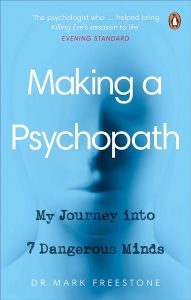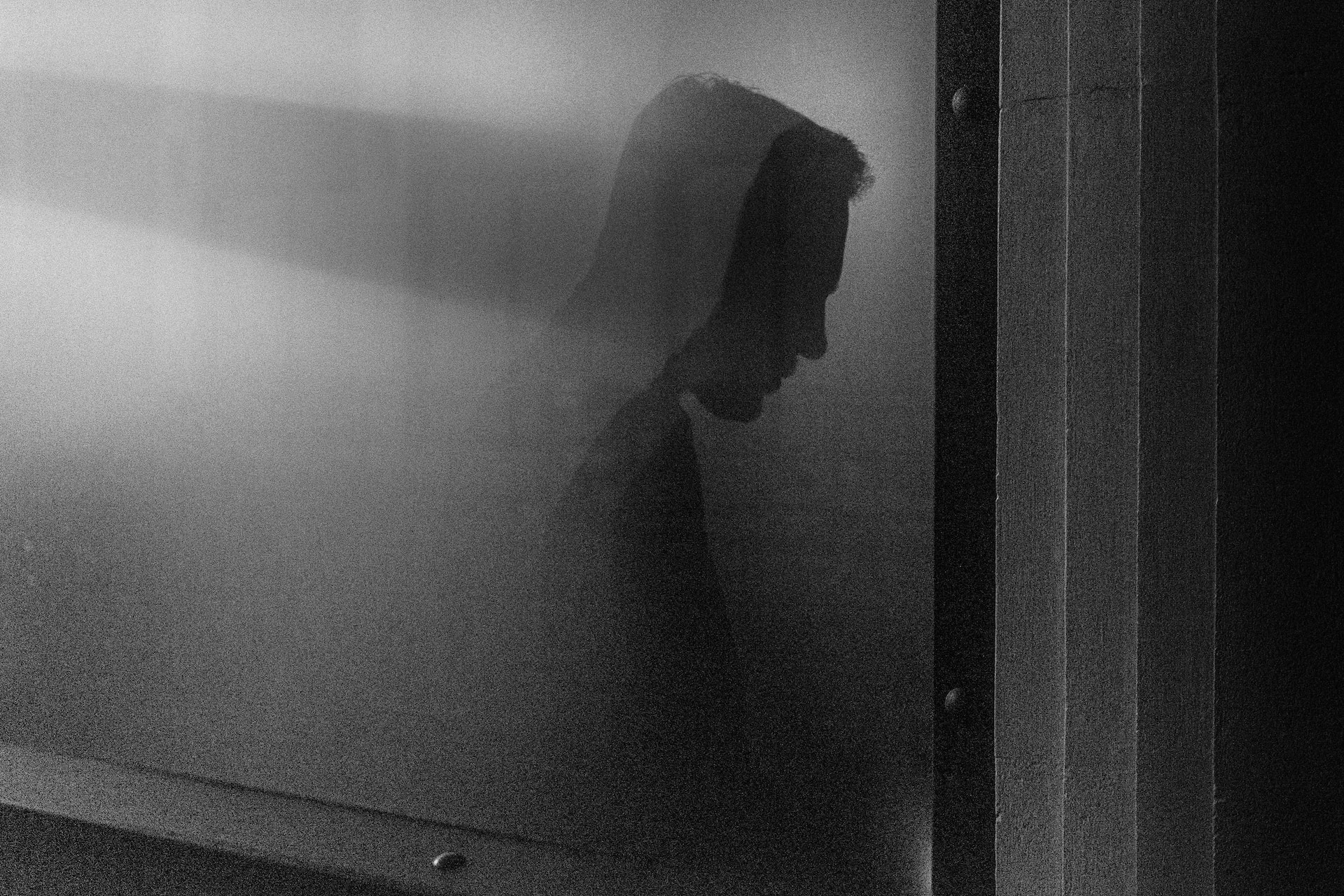
It might seem counterintuitive to describe Dr. Mark Freestone’s book exploring psychopathy as a breezy read, yet that’s exactly what it was. That’s also why I found it this summer amongst the modest selection of books for purchase at London’s overcrowded Stansted Airport, catering to travellers seeking something comfortable enough to read while crammed into the narrow, hard seats of Europe’s low-cost airlines. The author must compete for the air traveller’s attention, which often strays during the flight to their physical discomfort. While Freestone approaches the topic of what makes a psychopath in a journalistic manner designed to appeal to broad audiences, he is also keen to dispel myths, sensationalism and gross oversimplifications that so often find their way into popular culture and discourse on this topic.
Freestone teaches at the Centre for Psychiatry, at Queen Mary University of London. He had also worked as a consultant on a BBC America television series exploring psychopathy, entitled Killing Eve. This book, however, is mostly based on his experiences working in prisons and secure mental health facilities in the United Kingdom in the early 2000s, when he was starting off as a young professional. That Freestone landed a non-fiction book deal from an imprint of Penguin Random House, however, probably had some connection to his work on a popular television series.
Originally, he approached this work from a sociology background. I think that explains his focus on seriously considering the environmental factors that contribute to criminal psychopathy. What we learn from Freestone is how genetics, malformed or reduced activation of certain regions of the brain, and trauma or abuse especially in youth are the key factors in criminal psychopathy. A psychopath is unable to read emotion in someone else, struggles to feel emotion and remorse, understand and display empathy, and to assess risk.
Yet having abnormal brain structures or functions consistent with psychopathy, particularly in the prefrontal cortex and the amygdala, do not predestine someone to criminal psychopathy, even if it does leave a mark on their emotional responses and capacity to build relationships. Freestone tells the story of renowned neuropsychologist James H. Fallon, who discovered by accident during his academic research — while looking through PET scans, one of which turned out to be his own — that his brain met the criteria of psychopathy. Yet he had built a respected academic career and maintained a healthy family life.
It’s also entirely possible for someone with a deeply traumatic childhood and experiences of abuse to then go on to build healthy relationships, a stable life and career, and not engage in criminal behaviour. And, of course, only a very small minority of those who experience childhood trauma also experience psychopathy, even if that trauma can lead to a range of mental health issues in adulthood. What Freestone emphasises is that criminal psychopathy “depends on a complex interplay between early experiences and genetics, both of which play a part in the formation of the adult brain.” But he also adds that in all his interactions in prisons and mental hospitals, he has never met a criminal psychopath who had a stable, healthy childhood. That last point is key, as it helps us get beyond the simplistic, unhelpful and even cruel portrayals of psychopaths as monstrous, keenly manipulative evil-doers without any sense of right and wrong. That view does not take into account environmental factors, sees no future for the criminal psychopath other than permanent imprisonment or, in the United States, sometimes the death penalty. They are seen as irredeemable and unworthy of mercy.
Yet are criminal psychopaths both perpetrators and victims? Freestone suggests that they often are — which makes it all the more taxing to engage with them as a mental health professional or an authority figure in the justice system. Compassion fatigue, especially when dealing with a manipulative and serially lying offender, must be a reality for those in this field.
Freestone presents us with the stories of seven different psychopaths. These do not quite rise to the level of case studies, but are perhaps closer to vignettes. Six of the seven cases involve male psychopaths and only one is a female — and she is not a case that Freestone worked on professionally. This gender proportion reflects the fact that the vast majority of psychopaths are men. Female psychopaths are exceedingly few and far between. Freestone estimates that out of every 1,000 men there are 3 diagnosed psychopaths, while in the case of women the proportion is 6 out of every 100,000.
One of the cases, a middle-aged man named Eddie, does turn his life around despite suffering abuse as a child at the hands of a brutish stepfather, witnessing the abuse his mother also suffered, then engaging in a litany of violence as a young adult and responding to himself, his actions and to others as a psychopath might. Freestone sits with the reformed Eddie, in his London home, enjoying coffee and cake. It was a long, uneven road to where Eddie is today, a functioning member of society, and there were plenty of failures and relapses into violence along the way. The statistics aren’t good — one success out of seven among the cases presented in this book. But if the psychopath seeks professional help at the right time, shows accountability for his actions, and if professional help is actually available in the overstretched health care system, then there is a fighting chance.
Freestone explores systemic issues as well. Is prison the right place for a psychopath when the nature of the institution may often deepen and promote the worst anti-social behaviours of the inmate, making recidivism more likely if or when they are released? Is a secured mental health facility a better place? If it is, how does one keep the neighbouring outside community safe and ensure that it isn’t easier for patients to abscond than if they were inmates in a prison? The chance of re-offending is extraordinarily high. Freestone speaks of a mental health facility in the Netherlands as a unique model — one that had been developed in Britain, yet was only fully implemented in this small continental European country. Here, staff take a big step back and empower the patients to run and regulate their own community, including handling fellow patients when they become unwell or unruly.
One of the surprising questions raised in the book is what to do when the criminal psychopath feels so at home in prison or a secure hospital, that any talk of a potential, future release date elicits an emotional, negative and even violent reaction?
The story of Danny was perhaps the most heart-wrenching, because the subject was so utterly vulnerable, despite his history of violent crimes. “We approached a young man, who can’t have been much past 18 but had the pale, sallow complexion and red-raw eyes of someone who has already spent a lot of time in institutional care. He looked as though he might fall over from the breeze at any given moment,” Freestone writes of Danny, who had all-but fatally stabbed a priest of the Church of England who had reached out to him pastorally in his time of need. Like all the people introduced in this book, Danny had an awful childhood. As a young boy, his mother would hide him in a drawer to spare him the violent wrath of his abusive father. Eventually, he ended up bouncing from foster home to foster home. He lacked an identity, stability and positive male role models.
Nurses in the hospital called Danny a heart-sink patient. His weakness, vulnerability and constant self-harm, especially involving his genitals, made it hard not to care for him. Yet this is where Freestone discusses such an important topic in this line of work, or indeed in pastoral work too: maintaining boundaries. Freestone writes: “I had to find a way to limit the empathy I felt with them; not because they were undeserving of it, but because the potential damage to my own state of mind was too great. I wondered if this was why I was warned about heart-sink patients; it wasn’t that they were dangerous to us physically, but rather to our own mental states.”
The chapters provided a good, contextualized portrayal of the characteristics often present in psychopathy. We meet the seemingly master manipulator, as well as the bald-faced liar who may know that the person across from him is aware that what he is saying is untrue, yet continues to fabricate the narrative. We meet men with charisma and sway, the one who intimidated just with his presence, the sad, pathetic sight of a vulnerable man who engages in awful acts of self-harm and the one who can turn on a dime, always on the verge of violence. The one story that I think doesn’t fit and doesn’t really add to this book is that of Angela. The author did not work with her; he is relaying information available in the public domain on a notoriously unrepentant American psychopath. She is a rare example of a psychopathic female. It seems out of place in this collection, which is otherwise based on Freestone’s personal observations and interactions in prisons and secure hospitals in Britain.
Perhaps the only other things with the potential to distract from the main themes and flow of the book are the numerous pop culture references and comparisons to characters in various Hollywood films or in games. I imagine that many readers, including this one, could not recognize or picture these references with sufficient speed and ease to not distract from focusing on the relevant story or information shared in the given chapter. Cultural references are tough to do. When they are done well, they take the reader deeper into the story that the author is telling, rather than drawing the reader’s thoughts away — even if for a few moments.
Many academics aren’t able to effectively communicate their research to broader audiences. The end result is that their work is shared before nearly empty conference rooms to one another, or in peer-reviewed journals with the sparsest readership of fellow researchers. Sometimes, more capable writers will use research published by academics to write readable books for a broader audience. Freestone, as an academic, is gifted in producing an accessible book on an important and misunderstood topic. He eschews the sensationalised Hollywood characters that all but equate psychopathy with the demonic. Yet he also doesn’t sanitize the story of psychopathy, especially its frightening manifestations. And, in an act of humility, he recognizes that there is much that remains unknown, including to the experts. One of the most powerful aspects of this book is how the author takes us along his own process of learning, trial and error as a young professional in an exceptionally difficult field.

What an amazing summary Chris! This book touches on a topic very close to home for myself and many others who are/have grown up in today’s dis-functional society and experience abuse/neglect/trauma or other environmental factors that lead to psychopathological behaviour. I’ve spent many hours on many late, rainy nights searching the depths of my own thoughts about this exact topic and pondering about my own experiences that have led to my own professional diagnosis, and how the upbringing I am a product of has led to these diagnosis. Dr. Freestone’s telling of his own research trials with 6 of the 7 patients spoken of within this book, in my opinion MUST be considered required reading material for anyone who wishes to travel down such a complex rabbit-hole of study. This book will undoubtedly bring about many answers and many more questions for one to search for the answers to. The delicate topic of psychology and mental health appears to be approached carefully and responsibly by Dr. Freestone, and I am greatly looking forward to reading this book. Thank you for sharing this interesting discovery Chris!